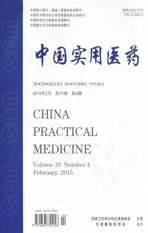冠心病合并2型糖尿病患者糖基化终产物与单核细胞TLR4的关系
2015-05-08张晓丹赵红丽
张晓丹 李 潞 赵红丽
·论著·
冠心病合并2型糖尿病患者糖基化终产物与单核细胞TLR4的关系
张晓丹 李 潞 赵红丽
目的 探讨分析冠心病(CHD)合并糖尿病(DM)患者糖基化终产物(AGEs)与单核细胞toll样受体4(TLR4)的关系。方法 CHD+DM患者58例(CHD+DM组), CHD患者60例(CHD组), 健康对照组50例。采用酶联免疫吸附测定(ELISA)法检测各组的AGEs, 用流式细胞仪检测外周血单核细胞TLR4mRNA相对表达量及TLR4阳性单核细胞比率。结果 与健康对照组比较, CHD+DM组及CHD组AGEs及外周血单核细胞TLR4mRNA相对表达量、TLR4阳性单核细胞比率明显增高(P<0.05);CHD+DM组与CHD组比较, CHD+DM组AGEs及外周血单核细胞TLR4mRNA相对表达量、TLR4阳性单核细胞比率增高(P<0.05);相关性分析显示升高的AGEs与升高的TLR4mRNA相对表达量及TLR4阳性单核细胞比率呈正相关。结论 CHD+DM患者AGEs及TLR4表达高于CHD患者;CHD患者AGEs及TLR4表达高于健康对照组。AGEs与TLR4的表达呈正相关。
冠心病;糖尿病;糖基化终产物;toll样受体4
流行病学调查资料显示, 糖尿病(diabetes mellitus, DM)患者发生动脉粥样硬化(AS)和心血管疾病的危险性较常人增加3~4倍。糖尿病患者在长期高糖刺激下, 体内蛋白质和脂质将发生非酶糖基化, 导致多种异构体在体内蓄积, 统称为AGEs。AGEs与细胞膜上的糖基化终产物受体相结合, 促进糖尿病大血管并发症的发生发展[1]。
Toll样受体4(toll like receptor 4, TLR4))是近年来发现的天然免疫识别受体, 能够识别病原体共有的病原相关分子模式并介导其跨膜信号传导[2]。若TLR4 被激活, 将启动胞内信号转导, 最终激活NF-κB, 诱导单核/ 巨噬细胞产生免疫炎性细胞因子、共刺激分子以及粘附分子等, 从而参与粥样斑块形成和破裂。通过对人及小鼠模型的AS组织切片进行免疫组化分析, 发现TLR4在粥样斑块组织表达, 尤其在巨噬细胞浸润、脂质丰富的部位明显表达[3,4]。
1 资料与方法
1.1 一般资料 入选2013年9月~2013年12月于本科住院的冠心病(coronary heart disease, CHD)+DM(CHD+DM组)患者58例, 男37例, 女21例;入选同期住院的CHD患者(CHD组)60例, 男34例, 女26例;另健康对照组50例, 男27例,女23例。三组一般资料比较, 差异无统计学意义(P>0.05),具有可比性。冠心病诊断标准根据第7版《内科学》;糖尿病者均符合1999年WHO糖尿病诊断标准。排除标准:①心肌梗死、脑血管意外、妊娠及严重肝肾功能不全除外;②糖尿病急性并发症;③甲状腺疾病、自身免疫性疾病、感染性疾病及出凝血疾病;④恶性肿瘤及结缔组织病等。
1.2 研究方法 所有入选者均于住院后首次清晨空腹抽取肘静脉血6 ml, 无需抗凝, 3000 r/min离心20 min, 取血清置于-70℃冰箱保存, 批量测定。
1.2.1 糖基化终产物(AGEs)测定 采用ELISA法检测各组的AGEs。试剂盒由上海活乐生物科技有限公司提供, 批内差异<9%, 批间差异<11%。
1.2.2 测定外周血单核细胞TLR4mRNA相对表达量及TLR4阳性单核细胞比率 用流式细胞仪检测各组外周血单核细胞TLR4 mRNA相对表达量及TLR4阳性单核细胞比率。
1.3 统计学方法 使用SPSS13.0统计软件进行分析。计量资料以均数±标准差( x-±s)表示 。组间均值比较用ANOVA方差分析;计数资料采用χ2检验;相关分析选用Pearson相关分析。P<0.05为差异有统计学意义。
2 结果
2.1 各组患者AGEs及外周血单核细胞TLR4mRNA相对表达量、TLR4阳性单核细胞比率 与健康对照组比较, CHD+DM组及CHD组AGEs及外周血单核细胞TLR4mRNA相对表达量、TLR4阳性单核细胞比率明显增高(P<0.05);CHD+DM组与CHD组比较, CHD+DM组AGEs及外周血单核细胞TLR4mRNA相对表达量、TLR4阳性单核细胞比率增高(P<0.05)。见表1。

表1 三组AGEs及外周血单核细胞TLR4mRNA相对表达量、TLR4阳性单核细胞比率比较( x-±s)
2.2 CHD+DM、CHD患者AGEs与单核细胞TLR4相关性分析 CHD患者单核细胞TLR4表达增高, 合并DM时增高更明显, 且与AGEs呈正相关(r=0.643, P<0.05)。单核细胞TLR4与CHD合并DM的炎症反应加重有关。
3 讨论
大量研究表明TLR4信号通路的激活介导了众多炎症因子的表达。TLR4在动脉粥样斑块的内皮细胞、巨噬细胞、血管平滑肌细胞和血管外膜成纤维细胞表达均增高, 在冠心病患者外周血单核细胞表达增高。Devaraj等[5]研究发现, DM患者微血管病变者炎症介质表达水平高, 从而造成血管内皮细胞的严重损伤, 随后脂质沉积、血小板粘附, 血管舒缩受限等参与了AS的病理发展过程。
目前与糖尿病及AS关系最密切的一个物质就是AGEs。大量的研究证明:AGEs可促进AS的发生发展。AGEs与蛋白质的周转, 组织结构, 细胞氧化应激以及炎症等疾病有关联[6]。本研究结果所显示出的单纯冠心病患者血清AGEs水平升高也证实了AGEs与AS有关。目前认为AGEs可能通过以下途径促进AS发挥作用:①损伤血管内皮[7]。②促进白细胞粘附、聚集及活化[8,9]。③刺激血管平滑肌细胞增殖。④加快血小板聚集和血栓形成[10]。本研究结果显示各组间的AGEs水平差异均有统计学意义(P<0.05), 以糖尿病合并冠心病组为最高, 支持了上述理论, 说明AGEs在血管病变中起了一定的作用。衰老、高血糖、肾功能衰竭、氧化应激及炎性反应等因素刺激可促进AGEs的形成[11]。AGEs作为致病因素, 可以提示人们在治疗相关疾病中采取新的策略, 在新药筛选中具有重要意义[12]。
综上所述, 冠心病合并2型糖尿病AGEs与TLR4分子的表达呈正相关, 可揭示AGEs与AS的内在联系、作用方式,为防治糖尿病心血管并发症提供新的理论依据, 同时为新的诊疗技术及药物开发提供目标靶点。
[1] Brownlee M, Cerami A, Vlassara H.Advanced glycosylation end products in tissue and the biochemical basis of diabetic complications.N Engl J Med, 1988, 318(20):1315-1321.
[2] Tanaka K.Expression of Toll-like receptors in the intestinal mucosa of patients with inflammatory bowel disease.Expert Rev Gastroenterol Hepatol, 2008, 2(2):193-196.
[3] Xu XH, Shah PK, Faure E.Toll-like receptor 4 is expressed by macrophages in murine and human lipid rich atheroscler oticplaques a ndupregulated by oxidized LDL.Circulation, 2001, 104(25):3103-3108.
[4] Ishikawa Y, Satoh M, Itoh T, et al.Local expression of Toll-like receptor 4 at the site of ruptured plaques in patients with acute myocardial infarction.Clin Sci, 2008, 115(4):129-131.
[5] Devaraj S, Jialal I, Yun JM, et al.Demonstration of increased tolllike receptor 2 and toll-like receptor 4 expression in monocytes of type 1 diabetes mellitus patients with microvascular complications.Metabolism, 2011, 60(2):256-259.
[6] Zhu P, Ren M, Yang C, et al.Involvement of RAGE, MAPK and NF- kB pathways in AGEs-induced MMP-9 activation in HacaT Keratinocytes.Experimental Dermatology, 2011, 21(2):123-129.
[7] Tanaka N, Yonekura H, Yamagishi S, et al.The receptor for advanced glycation end products is induced by the glycation products themselves and tumor necrosis factor-alpha through nuclear factorkappa B, and by 17beta-estradiol through Sp-1 in human vascular endothelial cells.J Biol Chem, 2000, 275(33):25781-25790.
[8] Yamagishi S, Inagaki Y, Okamoto T, et al.Advanced glycation end product-induced apoptosis and overexpression of vascular endothelial growth factor and monocyte chemoattractant protein-1 in human-cultured mesangial cells.J Biol Chem, 2002, 277(23): 20309-20315.
[9] Ohgami N, Miyazaki A, Sakai M, et al.Advanced glycation end products (AGE) inhibit scavenger receptor class B type I-mediated reverse cholesterol transport: a new crossroad of AGE to cholesterol metabolism.J Atheroscler Thromb, 2003, 10(1):1-6.
[10] Uehara S, Gotoh K, Handa H.Separation and characterization of the molecular species of thrombomodulin in the plasma of diabetic patients.Thromb Res, 2001, 104(5):325-332.
[11] Kanauchi M, Tsujimoto N, Hashimoto T.Advanced glycation end products in nondiabetic patients with coronary artery disease.Diabetes Care, 2001, 24(9):1620-1623.
[12] 孙贺英, 张岑山, 张宗玉.人血浆、红细胞膜及皮肤组织的非酶糖基化反应的增龄变化.北京医科大学学报, 1998, 30(2):1.
Relationship between advanced glycation end products and monocyte TLR4 in patients of coronary heart disease complicated with type 2 diabetes mellitus
ZHANG Xiao-dan, LI Lu, ZHAO Hong-li.
The Second Affiliated Hospital of Shenyang Medical College, Shenyang 110002, China
Objective To investigate the relationship between advanced glycation end products (AGEs) and monocyte Toll-like receptor 4 (TLR4) in patients with coronary heart disease (CHD) combined with diabetes mellitus (DM).Methods There were 58 patients with CHD+DM (CHD+DM group), 60 patients with CHD only (CHD group), and 50 patients in healthy control group.Enzyme-linked immuno sorbent assay (ELISA) was applied to detect AGEs in all the groups, and flow cytometry was used to detect relative expression of peripheral blood monocytes TLR4mRNA and ratio of TLR4 positive monocytes.Results Compared with the healthy control group, CHD+DM group and CHD group all had remarkably increased AGEs, relative expression of peripheral blood monocytes TLR4mRNA, and ratio of TLR4 positive monocytes (P<0.05).Between the CHD+DM group and CHD group, the former had higher increased levels of AGEs, relative expression of peripheral blood monocytes TLR4mRNA, and ratio of TLR4 positive monocytes (P<0.05).The results of correlated analysis showed that there was positive correlation between increased AGEs, increased relative expression of TLR4mRNA, and ratio of TLR4 positive monocytes.Conclusion The expressions of AGEs and TLR4 of CHD+DM patients are higher than CHD patients, and those of CHD patients are also higher than healthy control group.AGEs and expression of TLR4 are positively correlated.
Coronary heart disease; Diabetes mellitus; Advanced glycation end products; Toll-like receptor 4
10.14163/j.cnki.11-5547/r.2015.04.001
2014-10-17]
沈阳市科技计划项目(项目编号:F11-262-9-18)
110002 沈阳医学院附属第二医院
